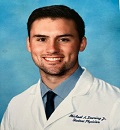Day 1 :

Biography:
Michael Downing is a third year medical student at NSU-KPCOM in Fort Lauderdale, FL. He completed a one year student fellowship (2019-2020) focusing on musculoskeletal medicine, sports medicine, and manipulative medicine. He hopes to pursue a future career in orthopedics.
Abstract:
During the past decade there has been an increased use of demineralized bone matrix (DBM) products for the use of fractures. DBM is an allograft obtained from human cadaveric bone that has osteoinductive and osteoconductive properties. DBM has a good safety profile, is cost-effective, and avoids issues seen in autologous bone grafts such as donor-site pain, infection, increased blood loss, and longer procedure times. There is a wide variety of specific DBM products, each with their own biochemical, safety, and efficacy profiles. This raises a question of which specific DBM product is superior to the rest. This study reviews comparison studies of specific brand DBM products, including Allomatrix, DBX, Grafton, Orthoblast and Osteosponge in an attempt to propose the most efficacious DBM product that can be used for bone grafting of various orthopedic fractures. We conclude that there is no definitive gold-standard DBM product for general orthopedic use due to the scarcity of clinical research comparing specific brand products, limited sample sizes of available studies, and lack of standardization in the creation and use of DBM products. We hypothesize that Orthoblast, Grafton, and Allomatrix would be the appropriate DBM products to use in areas of bone loss due to fracture. Grafton and Allomatrix are two of the most clinically researched DBM products in the setting of fractures, and Orthoblast outperformed Grafton in a low-power comparative study. However, given the limited sample size of these products in the context of periarticular fractures, caution must be taken when drawing theoretical conclusions about which DBM product is best for these types of fractures.
Keynote Forum
Khatri B
Central Institute of Orthopedics, VMMC And Safdarjung Hospital, New Delhi Delhi, India
Keynote: ROLE OF CT SCAN GUIDED BONE MARROW INJECTION IN POSTOPERATIVE CASES OF FRACTURE FIXATION WITH NONUNION IN LONG BONES
Time : 09:00 to 09:45

Biography:
Abstract:
Introduction: Fracture non-union is a relatively common problem faced by orthopedic surgeons after operative fracture fixation. Percutaneous Bone marrow injection given at non-union site has successfully shown union with significant low morbidity as compared to traditional open bone grafting. The purpose of our study was to use CT scan guidance to accurately locate the exact site of non-union, deliver an effective shot of autologous bone marrow injection and assess union time. Method: Under strict aseptic precautions bone marrow aspiration was done from posterior iliac crest using core biopsy needle in a heparinized syringe. Under CT guidance, multiple punctures were done over sclerosed non united fracture ends followed by percutaneous injection of bone marrow to stimulate union. All patients were followed up with serial radiographs and clinically with appropriate scoring systems. Results: 30 patients were selected for hospital based interventional based study with average time after operative fracture fixation of 9.5 months. After bone marrow injection, Follow-up period ranged from 6 to 8 months with average union time of 4 months and complete union in 24 out of 30 patients (80%). Failure was reported in six patients (20%).Conclusion: CT SCAN guided bone marrow injection is an effective method for treatment of delayed or non-union fractures with low complications. It has significant low rates of morbidity as compared to autologous bone grafting procedures and it reduces patient’s expenditure, hospital stay and gives good functional results. It can be tried for non-union before going directly to gold standard re-fixation and autologous bone graft
- ORTHOPEDICS 2021
Location: Online
Session Introduction
Khatri B
Central Institute of Orthopedics, VMMC And Safdarjung Hospital, New Delhi Delhi, India
Title: ROLE OF CT SCAN GUIDED BONE MARROW INJECTION IN POSTOPERATIVE CASES OF FRACTURE FIXATION WITH NONUNION IN LONG BONES
Time : 09:45 to 10:15
Biography:
Our Firm, B. Khatri & Co., provides wide range of services ranging from international tax, domestic tax (both direct and indirect), transfer pricing, expatriate tax and regulatory matters, representation, assisting in business reorganizations, tax due diligence, etc. We also provide assurance, accounting, payroll, valuation, incorporation, incubation, virtual office services among others. Since the introduction of GST, we have been involved in assisting client.
Abstract:
Fracture non-union is a relatively common problem faced by orthopedic surgeons after operative fracture fixation. Percutaneous Bone marrow injection given at non-union site has successfully shown union with significant low morbidity as compared to traditional open bone grafting. The purpose of our study was to use CT scan guidance to accurately locate the exact site of non-union, deliver an effective shot of autologous bone marrow injection and assess union time. Method: Under strict aseptic precautions bone marrow aspiration was done from posterior iliac crest using core biopsy needle in a heparinized syringe. Under CT guidance, multiple punctures were done over sclerosed non united fracture ends followed by percutaneous injection of bone marrow to stimulate union. All patients were followed up with serial radiographs and clinically with appropriate scoring systems. Results: 30 patients were selected for hospital based interventional based study with average time after operative fracture fixation of 9.5 months. After bone marrow injection, Follow-up period ranged from 6 to 8 months with average union time of 4 months and complete union in 24 out of 30 patients (80%). Failure was reported in six patients (20%).Conclusion: CT SCAN guided bone marrow injection is an effective method for treatment of delayed or non-union fractures with low complications. It has significant low rates of morbidity as compared to autologous bone grafting procedures and it reduces patient’s expenditure, hospital stay and gives good functional results. It can be tried for non-union before going directly to gold standard re-fixation and autologous bone graft.
Alexander Frost-Younger
Royal Victoria Infirmary, Newcastle upon Tyne, United Kingdom
Title: LENGTH OF STAY COMPARISON IN PATIENTS REQUIRING SURGICAL INTERVENTION FOR WRIST FRACTURE: A SMALL STUDY FROM A TRAUMA CENTRE
Time : 10:15 to 10:45

Biography:
I attended Newcastle University and graduated in 2016 with a Bachelor of Medicine and Surgery. I hold a GMC Registration with 'Full License to practice' and completed my Foundation Programme Training in the Northern Deanery 2016-2018. During my medical education, I have developed an interest in Emergency/Acute Medicine, Surgery and Radiology. I will be applying for specialty registrar training in Surgery this year.
Abstract:
Authors: Dr Alexander Frost-Younger. Royal Victoria Infirmary, Newcastle upon Tyne, United Kingdom NE1 4LP
Background: Isolated wrist fractures are one of the most common fractures in both children and adults. In 2008 the overall fracture incidence for the UK population was calculated at 3.6%(1). However, studies comparing patient length of stay (L.O.S) for fracture surgery are sparse.
Method: A small retrospective study examining 90 patients with isolated wrist fractures requiring surgical intervention between Sept 2018-Sept 2019. Exclusion criteria included multiple fractures, polytrauma and concomitant medical conditions on admission. Patient Demographics and admission dates (Winter/Non-winter and Weekday/Weekend) were compared by calculated L.O.S averages.
Results: Patients >60 (n=2.1), patients requiring ORIF (n=2.0) ASA Grade >1 (n=1.9) had the highest average L.O.S. Seasonal and weekly variation was noted, with patients having a higher L.O.S if they were admitted during Winter (n=1.7) or over the weekend (n=1.6), in comparison to Non-Winter and Weekday admissions.
A.Laiz
Hospital Santa Creu i Sant Pau, Barcelona
Title: Ustekinumab and TNF Inhibitor Treatment in Spanish Patients with Psoriatic Arthritis: 6-month Follow-up from the Real-world Observational Study PsABio
Time : 10:45 to 11:15
Biography:
Ana Laiz MD is an Associate Professor of Rheumatology at Universidad Autónoma de Barcelona and works as a specialist in Rheumatology at Santa Creu I Sant Pau Hospital (Barcelona, Spain).
Abstract:
PsABio (ClinicalTrials: NCT02627768) is a prospective, observational, real-world cohort study collecting data on patients with a confirmed diagnosis of PsA starting either ustekinumab (UST) or a new TNF inhibitor (TNFi) in 8 European countries. The purpose of the study PsABio is to evaluate the efficacy, tolerability and persistence of ustekinumab and TNFis for adult patients with PsA according to CASPAR criteria commencing first-, second- or third- line bDMARDs in real-world routine clinical management.
This interim analysis presents 6-month follow-up data on joint-related outcomes in the Spanish cohort.
Arpit Patel
Royal Free Hospital, London, United Kingdom
Title: Septic arthritis secondary to PVL toxin producing staphylococcus aureus
Time : 11:15 to 11:45
Biography:
Mr Arpit Bakulash Patel MBCHB, BSC(Hons), MRCS (England), PGCert (Medical Education) Core Surgical Trainee, London Deanery
Abstract:
Introduction
Panton-Valentine Leukocidin (PVL) toxin producing strains of staphylococcus aureus are known to cause severe skin and soft tissue infections. We present a case report of a patient who suffered from septic arthritis and overwhelming sepsis from proven PVL toxin secreting staphylococcus aureus.
Case Study
A 13 year old boy presented to the Emergency Department with a one day history of right sided hip pain and an inability to weight bear, one week after incision and drainage of a left sided buttock abscess. He was systemically unwell with raised inflammatory markers and continued to deteriorate despite Co-Amoxiclav and washout of the hip. Post-operatively, ongoing pain led to an MRI that showed worsening right hip septic arthritis with extensive inflammatory changes. A change of antibiotics to Rifampicin and Trimethoprim following PVL isolation and second washout led to improvement.
Discussion
The literature supports that beta-lactam antibiotics increase the expression of staphylococcus aureus PVL toxin by activating its transcription leading to a greater systemic inflammatory response. Patients usually present with minor skin infections however rarely, invasive infections can occur including septic arthritis. An MDT effort to achieve early surgical management with tailored antibiotics can improve outcome as the use of penicillin can be detrimental.
